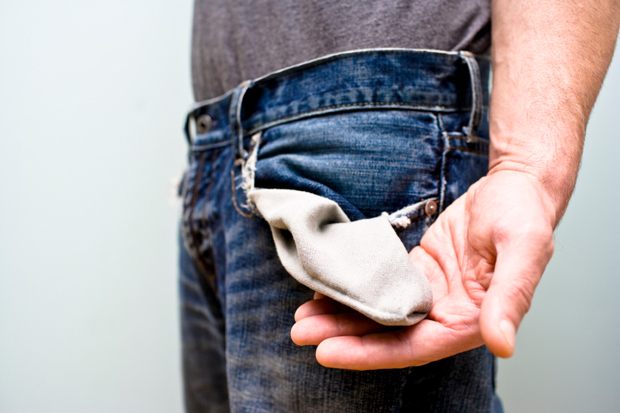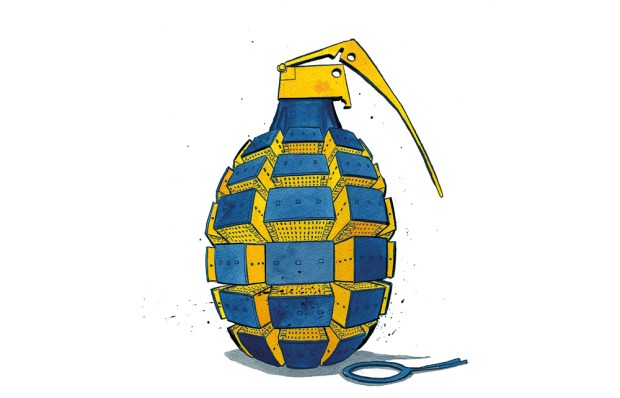Just after last year’s general election, George Osborne delivered a budget that he hailed as proof that his policies were working. ‘The British economy I report on today is fundamentally stronger than it was five years ago,’ he crowed, as he started to detail the record number of jobs created and a growth rate that had accelerated past our neighbours. ‘Our long-term economic plan is working. But the greatest mistake this country could make would be to think all our problems are solved.’
As it turns out, this final sentence summed things up the best. There was growth but a whole lot of debt as well. The national debt today stands at £1,580 billion, some 50 per cent more than the Chancellor inherited. He was correct that we were growing faster than our rivals, even if, given the dire state of their economies, that was not much of a claim. Osborne was right too that lots of new jobs had been created — but at the expense of salaries which remained stagnant. Also, half of the employment growth derived from Britain’s ability to suck in immigrant workers.
Whenever equities start to crash, wise old heads quote the Nobel Prize-winning economist Paul Samuelson, who said that the markets had predicted ‘nine out of the last five recessions’. Today there is certainly some truth in that. Markets overreact all the time, and swing from elation to despondency faster than a toddler over-doing it on fizzy drinks. Even so, it is sometimes forgotten that Samuelson was also making another important point: the markets are right slightly more than half the time.
Since the beginning of the year, the markets have been behaving as if there was another recession looming. The price of oil has been falling drastically — dropping from $65 a barrel last May to under $40 now. Rumours have been swirling around some of the banks, most notably Deutsche Bank, the rock on which the German economy (and by extension the European economy as well) is built. It has all started to feel very 2008, and for a fairly simple reason — because it may well be.
A recession would hardly be that surprising. Another old piece of market wisdom holds that ‘every five to seven years everyone forgets that a downturn comes every five to seven years’. Booms and busts make a London bus look like a miracle of reliability, but even so, another bust is more than due. For the whole of the post-war period the average length of an economic expansion is 58.4 months (pre-war it was 35 months and in the Victorian era it was only 26). So where are we now? The British economy started expanding again at the beginning of 2010, so the recovery has now been running for 73 months. Much the same is true in the United States.
While there is some evidence to suggest that business cycles have become more elongated since the 1980s, this is still a heck of a long time. In reality, a downturn would be about as unexpected as football manager Louis Van Gaal getting fired from Manchester United. There is no shortage of signals that the outlook is worsening. The Baltic Dry Index, which measures the cost of those big container ships that ferry stuff around the world, has been crashing. Globally, world trade has stagnated. In the UK the revival of manufacturing (such as it was) has ground to a halt. In February, British industrial output suffered its sharpest fall for four years.
Lift up the bonnet and the British economy does not look in any better fundamental shape than it did in 2007. In many ways, along with the economies of the whole developed world, it is in much worse condition. In December, the Bank for International Settlements totted up global debt, and looked at how it had changed since the crash of 2008. The results were not encouraging — to put it mildly. It warned that far from coming down, debt was still exploding at an accelerating pace, to $140 trillion: 50 per cent more than in September 2007, when the credit crunch kicked off.
Over the seven years since the crash, the world has added as much to its total borrowings as it did in the seven years before the crash. And if the crash was a debt crisis, the work on fixing it has not even begun. Instead, the entire world has been running up yet more debt at a faster rate than ever, with the UK right at the front of the pack.
‘The Great Depression of the 1930s was a nine-year event,’ argued the US consultancy High Frequency Economics in a report last month. ‘Our hypothesis is that the rupture of 2008 caused greater damage than was immediately apparent. It still has not healed. We say the global economy is entering a third wave of contraction in a global depression that is now in its eighth year.’
True, the markets may have got this wrong. The economy may have recovered its poise by the summer and be humming along comfortably again. For as long as it is moving (and the cost of borrowing remains ludicrously cheap), it may not matter that the Chancellor is borrowing more than any of the European countries he loves to lecture.
But if we are staggering towards an overdue downturn, we will be doing so in far worse shape, and with far less scope to respond, than in 2007 and 2008. We faltered then, and borrowed to the hilt to recover. If we falter again, we may discover that Osborne’s ‘recovery’ was another debt-fuelled mirage. And the hard work of actually fixing the UK economy still lies ahead.
Got something to add? Join the discussion and comment below.
Get 10 issues for just $10
Subscribe to The Spectator Australia today for the next 10 magazine issues, plus full online access, for just $10.
You might disagree with half of it, but you’ll enjoy reading all of it. Try your first month for free, then just $2 a week for the remainder of your first year.
















Comments
Don't miss out
Join the conversation with other Spectator Australia readers. Subscribe to leave a comment.
SUBSCRIBEAlready a subscriber? Log in